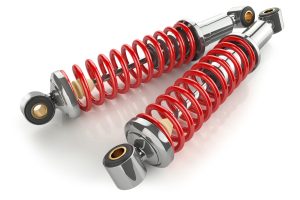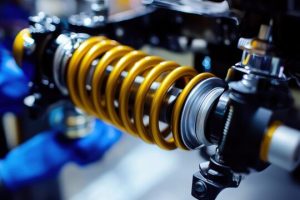In modern vehicles, the smoothness of your ride, the stability of cornering, and your ability to brake safely all depend on one foundational system: the suspension. At the heart of it lies a dynamic trio — shock absorbers, springs, and struts — forming what mechanics often refer to as the “Suspension Triangle.”
Understanding how these components work together helps drivers appreciate their importance and know when to service or replace them. In this article, we’ll break down their interaction, explain the mechanics behind it, and offer tips for maintenance and replacement — including where to buy Shock Absorbers online.

The Role of Each Suspension Component
| Component | Primary Function |
|---|---|
| Springs | Support vehicle weight and absorb road impact |
| Shock Absorbers | Control and dampen spring motion (oscillations) |
| Struts | Structural support + combine spring and shock into one unit |
How the Suspension Triangle Works
Each part of the triangle plays a specific role, and their performance is deeply interconnected.
1. Springs: The Load Bearers
-
Usually coil or leaf springs, they absorb bumps by compressing and expanding.
-
Their job is to absorb vertical movement.
-
However, springs by themselves cause a bouncing effect — they need to be controlled.
2. Shock Absorbers: The Motion Controllers
-
Shocks dampen the energy released by the springs.
-
Filled with hydraulic fluid or gas, they convert motion into heat.
-
Prevent oscillation after each bump and improve tire contact with the road.
3. Struts: The Combo Unit
-
A strut combines a spring, a shock absorber, and a structural mounting point.
-
They often replace the upper control arm in many front suspension designs.
-
Struts bear more load and also play a role in wheel alignment (camber).
Interaction Diagram (Function Relationship)
| Action | Spring Response | Shock Absorber Response | Strut Role |
|---|---|---|---|
| Hit a bump | Compresses | Slows rebound | Provides structure |
| Rebound after bump | Expands | Dampens motion | Maintains ride height |
| Hard braking | Front compresses | Resists nose-dive | Stabilizes alignment |
| Cornering | Side compresses | Controls body roll | Holds camber angle |
Why the Suspension Triangle Matters
Proper interaction among these three components leads to:
-
Smooth ride quality
-
Enhanced steering response
-
Stable braking and acceleration
-
Longer tire life
-
Increased safety at high speeds or during evasive maneuvers
Failure or wear in one part can reduce the effectiveness of the others.
Symptoms of Wear in the Suspension Triangle
| Symptom | Possible Cause | Action to Take |
|---|---|---|
| Excessive bouncing after bumps | Worn shock absorber | Replace shocks or struts |
| Uneven tire wear | Strut misalignment or worn shocks | Inspect strut & alignment |
| Nose dive when braking | Weak front shocks or struts | Replace worn components |
| Swaying during cornering | Failing shocks or weak springs | Test shocks; check spring sag |
| Clunking noise from suspension | Loose or damaged strut mount | Inspect mounts and bushings |
| Poor steering stability | Worn shocks or struts | Replace shocks; check bushings |
Suspension Maintenance Tips
To ensure optimal performance from your shock absorbers, springs, and struts:
-
Replace shocks and struts every 80,000–100,000 km or when signs of wear appear.
-
Check spring height to detect sag or fatigue.
-
Inspect mounting hardware and bushings regularly.
-
Perform wheel alignments after strut replacement.
-
Use OEM-quality parts or reputable aftermarket brands.
Types of Suspension Configurations
| Suspension Type | Description | Notes |
|---|---|---|
| MacPherson Strut | Combines spring and shock in one vertical unit | Common in front suspensions |
| Double Wishbone | Uses control arms with separate spring & shock | Common in sports & performance cars |
| Torsion Bar | Uses a twisting steel bar instead of coil spring | Older trucks, some imports |
| Multi-Link | Independent arms and shocks for precision | High-end vehicles |
Replacement Strategy: One or All?
Should you replace shocks/struts in pairs?
Absolutely. Uneven damping causes handling imbalance.
What about springs?
If one spring is sagging or cracked, the other may follow soon — replace in pairs when possible.
Where to Buy Quality Shock Absorbers

Looking for dependable replacement parts? Don’t compromise your vehicle’s safety and comfort. Choose from a wide range of compatible options with trusted quality:
buy Shock Absorbers online — fast shipping, OEM-fit options, and expert support available for most vehicle brands.
Final Thoughts
The suspension triangle — shock absorbers, springs, and struts — is fundamental to your vehicle’s comfort, handling, and safety. While each part has a unique role, their interaction is what keeps your car stable over rough roads, sharp turns, and sudden stops.
Understanding how they work together helps you:
-
Diagnose handling issues,
-
Prevent uneven tire wear,
-
Maintain control during emergencies,
-
And preserve the long-term health of your vehicle.
Check your suspension regularly and replace all worn components together to avoid a domino effect of failures. Your safety and comfort depend on it.